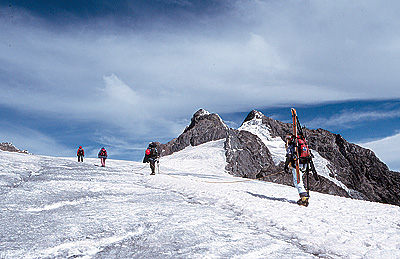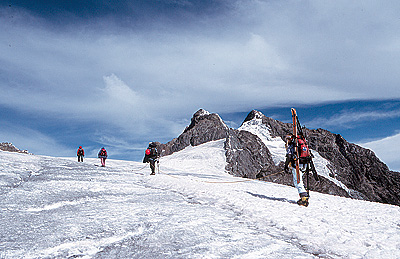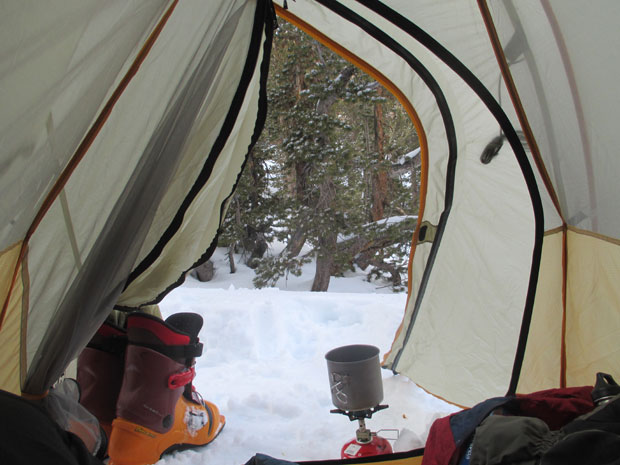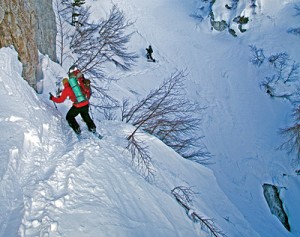- Tahoe’s Nevada Beach Tops the List of Hard-to-Book Campgrounds - 07/17/2024
- Cannabis Watershed Protection Program Cleans Up Illegal Grow Sites - 07/10/2024
- French Fire - 07/05/2024
My Obsession to Ski the Vanishing Snowfields of the Rwenzoris
By Nicole Dreon 
Crossing the Elena Glacier in 2005. Photo: Harry Kikstra.
“The Mubuku River is too high – too high for the dry season,” our Ugandan guide John says, shaking his head. He fears we might not be able to cross the footbridge ahead.
We’ve only been hiking for a few hours and already the trail is lapped over by whitewash. The river rampages through the rainforest right next to us. It is the kind of water that would make the evening news back home – the kind of water that leaves people stranded on their rooftops while a TV helicopter hovers nearby.
This is my second trip to the Rwenzoris Mountains in central Africa. Translated from the Bantu tribal language, Rwenzoris means “Rainmaker.” The range, which rises from dense equatorial jungle and is more often than not shrouded in clouds, is often cited as the source of the Nile River. Splitting the difference between the Democratic Republic of the Congo and Uganda, the Rwenzoris are Africa’s most glaciated mountain range. Its highest peak, Mt. Stanley, tops out at over 16,000 feet, third highest on the continent.
I have come here all the way from the pine and sage of Truckee, CA, with my close girlfriend Shannon Rahlves. From the Ugandan capital of Kampala to the mountain’s base, we have traveled for eight hours on a bus so packed with villagers dressed in colorful sarongs and headpieces that the rusty bus tilts sideways. If we weren’t already conspicuous, I am carrying with me a pair of snow skis. When we reach the end of the line, and I try to squeeze off the bus, I threaten to decapitate half of my fellow passengers with them.
“Excuse me, pardon me. Excuse me, pardon me,” I apologize.
Why in my right mind am I hauling some old K2 Explorers through central Africa? Because I hope to carve a few turns on the remaining glaciers clinging to Mt. Stanley before they’re gone.
See, the global warming bell is ringing loudly and ominously in the Rwenzoris. If the current rate of glacial receding persists, experts predict the snow will be gone in 20 years. According to Uganda’s environment ministry, the melting of the ice fields could threaten fresh water supplies to hundreds of thousands of people.
And for me? Well, it threatens my selfish desire to tell my yet-to-be kids that I once skied the source of the Nile.
Denial at the Head of the Nile
My Ugandan ski fixation stems from a previous failure, for it is my second trip here with skis. Two years before, in February 2005, I was here with another team that included noted Everest climber Alison Levine from San Francisco. I was the only one foolish enough to bring skis, even though my ski mountaineering experience was thinner than Sarah Palin’s foreign policy credentials. It amounted to little more than a Level 1 avalanche course, a couple Tahoe backcountry ski descents, finishing in the top five in a handful of big-mountain free-skiing comps … oh, and being able to see snow-capped mountains from my house!
I figured that since I could confidently bomb down most anything at Squaw, what could an equatorial glacier present that would challenge my all-mountain shred-readiness?
We all made it to the summit that first expedition, but the thorn in my ego ever since was that my overarching desire to ski in this most unlikely destination was never consummated. The conditions were icy. I was uncertain about the rocky terrain littered with small crevasses. And once I was on the lofty stage, self-confidence in my mountaineering abilities – such as the ability to self-arrest with the shiny new ice ax my mom gave me for Christmas a month before we landed in Kampala – eluded me under a wash of fatigue.
The Interim
After getting schooled by a couple of tropical glaciers, it took me two years to scrounge up enough cash to return to Uganda for redemption. In the interim, I moved from Truckee to San Francisco so I could work multiple jobs to save for such a trip. I logged hours as a freelance writer, bartender, and as a temp at an ad agency downtown. I also enrolled in documentary film classes. Not only would I go back to ski the source of the Nile, but I now added the pressure of documenting the trip.
What I didn’t do was pad my mountaineering resume. My ice ax was as shiny as ever when I got back on the plane a second time last year, this time with a new climbing partner, Shannon Rahlves. While Shannon thinks that bringing a pair of skis to Africa is ridiculous (and indeed she has left hers in her garage) she still shares my intoxication with seeing these dwindling snowfields before they disappear, if not my obsession to ski them.
The Best Laid Plans … Soaked
Back in Uganda, the Rwenzoris are living up to their rainy reputation. It is miserably wet. The downpour is so intense that we can’t even look up to see where we’re going. Our gum boots are filled with water and every step it squirts between our toes. My nylon backpack is so water logged that it practically yanks me backwards as the trail jogs up and down.
Ahead of us, our guide’s fears are confirmed. The swollen river has washed out the usual crossing. But John, a calm, soft-spoken veteran guide in his late 30s, spots a fallen tree that spans the width of the river, barely linking both banks.
“Give me the rope,” he says to me.
Oh no, I think, as my stomach sinks. I have come to Africa to go skiing and now I am afraid I might drown.
Lean and agile, John belongs to the Bankanjo tribe that is native to the Rwenzoris. He doesn’t hesitate. Crossing the log without protection, he jimmies the rope above the downed tree to provide a static grab line. One by one, he coaxes us to cross.
Ominous scenarios of slipping off the log and being swallowed by the swollen river play out in my mind. Pushing them back, I step on to the log and begin inching my feet across, side to side, while clasping the line hand over hand for some 30 feet. Shannon follows behind without any apparent tentativeness.
Today we have crossed, but tomorrow there will be more rivers.
No Reservations Necessary
Most people have never heard of the Rwenzoris – for a good reason. Accessing them from the Democratic Republic of the Congo is almost impossible because a Hutu extremist group left over from the Rwandan genocide terrorize the Congo’s eastern borders. According to the International Rescue Committee, since 1998 more than 5.4 million people have died from war-related causes, the deadliest documented conflict since World War II.
The Ugandan side, which we opt for, is a safer option, but it has also had its share of problems. From 1996-2001, it was the base camp for the Allied Democratic Forces (ADF), a rebel group that was fighting the Ugandan government.
While the continent’s most popular climbing destination, Mt. Kilimanjaro, averages well over 20,000 climbers a year, the Rwenzoris’ chaotic climate and remote location limit it to about 400 adventurous souls a year. It is not surprising then that Shannon and I spend almost the entire seven days on the trail alone. The mountain is a ghost town.
So This Is the Dry Season?
The day we climb from Nyabitaba Hut to John Matte Hut, we are pummeled by yet another tropical rainstorm. At one point the thunder cracks so loudly, I leap like a wild animal into the bushes for cover. It is this type of excessive rain that makes plants like the native giant lobelia grow to epic proportions. Towering overhead along the trail, they make the perfect backdrop for a sci-fi movie.
It is also this type of rain that makes the trail so diluted that we sink into mud up to our thighs step after step. When we try and pull our feet out, it makes that suction cup noise. Sometimes our feet lift right out of our boots. Other times it feels like our hips are pulling out of the socket. The trail twists and turns over rocks, under tree branches, and over stumps. With five different vegetation zones, the Rwenzoris are a freakish kaleidoscope of nature. One moment we cling to tree vines, while the next we zigzag through bamboo forests.
As if these rugged conditions weren’t enough to wear me down, Shannon is on fire. A world-class triathlete who can run sub six-minute miles off the couch, Shannon is setting a blazing pace. At one point, out of sheer exhaustion, I slip and fall like grandma in the shower. As I roll around on the ground bemoaning my hip, I lament the fact I haven’t befriended more coach potatoes.
Our Posse
When we finally reach John Matte Hut, the sun briefly pokes through the clouds. As I look around, I can’t believe how many people are with us. We need all these people I think to myself? I feel so high maintenance.
In addition to our head guide John, there is Malibina, the only woman guide in the Rwenzoris. As a young girl her father, also a guide, brought her along on trips to work as a porter, which is how she got experience as a climber.
Then there is an entourage of porters. Robson is our favorite because whenever he is near us we feel safe. I joke with Shannon that he is my boyfriend and that she better stay away from him. Then there is our cook Daze, as well as porters for the porters.
We have also hired three women porters, Beluse, Jen and Janet (who is Malibina’s little sister). Malibina herds them around like little ducklings. If they can’t carry their loads across the river, Malibina goes back and carries them herself. If she thinks their loads are too small, she summons them back to the campsite and loads them up with more. I tower over Malibina when I stand next to her, and I am only 5’ 4”.
At night, long after Shannon and I have crawled into our sleeping bags, the campsite sounds like a fraternity party. The co-ed porters, with their small radios pumping African tunes, hoot and holler until sunrise. We can always hear Malibina’s voice above all the others. Sometimes she talks heatedly and fast, other times she just laughs.
Many More Rivers To Cross
It is Malibina who stands outside our hut impatiently the morning we are to head from Bujuku Hut to Elena Hut, the last hut before we attempt to summit Mt. Stanley and I attempt once more to ski. She and John tell us that if we reach the summit, we should come back down the same way we went up instead of forging ahead over Scott Elliot Pass and completing the Central Circuit. If we go that way, they warn us, we will have to cross the Mubuku and Bujuku Rivers “many, many times.” We could get stuck if the rains return.
“How many times do we cross the river, Malibina?” we ask.
“Many,” Malibina speaks forcefully. “Five!”
I don’t like the sounds of this, but I also don’t want to come back down the same way we went up. We paid to hike the entire Central Circuit when we registered with the Rwenzoris Mountain Services in Kampala. Despite the risk and a nagging feeling in my gut, Shannon and I decide to roll the dice and move on. Our guides reluctantly agree.
Glacial Retreat
The trail climbs steeply up towards Elena Hut. Slowly the vegetation begins to disappear and by the time we arrive at the hut there is nothing but rocks. It feels lonely and empty. We are supposed to spend the night here and leave for the summit early in the morning. John gages the sky dubiously. “We should go now,” he tells us, even though it is already afternoon. If we pass up a chance to climb while the sky is clear, we might get shut out later.
Our plan is quickly sorted. Shannon and John will make a hasty push for the summit, while Malibina and Robson will come with me so I can try and make some turns.
Only a couple of decades ago, the glacier spilled onto the doorstep of Elena Hut, now it takes Malibina, Robson and me close to two hours of hard-core scrambling over rocks and boulders before we reach anything white. When I am finally booted up in my old Raichle race boots, ready to appease my long-held obsession, I hand Robson my small video camera. “Green light is good,” I try to explain to him and point to the snow in front of us. “Please film me.”
Steep Cost Per Turns Earned
Then, while he and Malibina stand at the bottom of a short but relatively steep pitch, I start to climb. It doesn’t take long before the initial pitch flattens out. The Stanley Plateau would offer a longer, steeper descent (if it isn’t frozen solid), but that is still a three or four hour hike away. There is no time for that today. What I am about to ski reminds me of Brantling Mountain in central New York. As kids, we would go there every Christmas Eve for a slalom race because we knew U.S. Ski Team members like Diana Roffe would show up. There was never enough snow, and the course was set around patches of grass and dirt. Each run lasted less than 20 seconds.
That is how long my run is going to be now, if I milk it. I flop my skis down and step into the bindings. I shout to Malibina to see if my “boyfriend” Robson is ready to film me. I can hear her voice sound back, “Yes, yes.” I push off slowly and carefully, like a soccer mom in a one-piece powder suit. I manage to squeak out four turns before I pull up in front of a pile of rocks. I am thankful for this rare, one-inch of fresh snow – otherwise I might do a death slide into the Congo. When I play back the video, I watch my body bob in and out of the frame like a ping-pong ball.
After I hike up and make four more turns on the same face again (for a grand total of eight!), we decide to pack it up. We still have a healthy descent and the rocks are now slippery. After 30-minutes of cautious baby steps, I toss my ski boots ahead of me to even out my load. I watch them begin to cartwheel down the slippery rock-strewn slope. I imagine this is what my body would look like if I lost my footing now.
Back at the hut where I shed wet layers, I worry about Shannon. The summit is far and there are many crevasses on the Stanley Plateau. Another guide shakes his head. He tells me my friend will be on the mountain a long time. It was not good that she went up so late.
An hour later, Shannon’s voice pierces through the mist near snowline. She and John are making their way back down. I am relieved they had the sense to turn around. Later when she tells me they went all the way to the summit, I don’t believe her until I see the photo. John just shakes his head and sighs, “I have never seen anyone climb so fast.”
As for me, eight turns seem a bit anticlimactic, especially when I think about how long the journey was to get here. Still, I relish this small, personal, epic accomplishment. There is maybe nowhere else in the world where a snowcapped peak makes a more jutting contrast to the landscape than here. It is the most stunning of contradictions. And someday, when the Rwenzoris’ snow is gone, I will tell my children about it.
“Once upon a time,” I’ll say, “when snow fell on the equator high above the jungles of Africa, your mom arced a few turns at the source of the Nile … Sorry about the whole global warming thing.”













